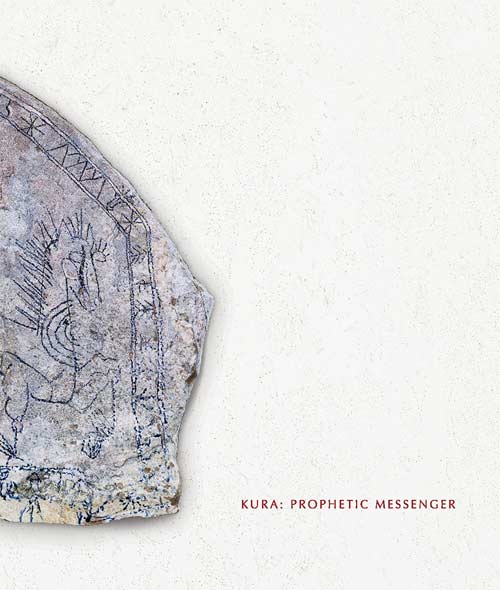Kura: Prophetic Messenger — the companion book to the sculpture that became the first permanent installation in the Jon Hassler Sculpture Garden on the grounds of Saint John’s Abbey and University in Collegeville — continues to be a juggernaut when it comes to piling up awards.
The latest came in June when it was named the winner in the highly competitive Arts, Photography and Coffee Table Books category at the 32nd annual Midwest Independent Book Awards, which “recognize creativity in content and execution, overall book quality, and the book’s unique contribution to its subject area,” according to the organization.
“It’s phenomenal,” said Margaret Bresnahan, who oversaw the book’s production and served as managing editor. She is the daughter of Colette Bresnahan ’83 and Richard Bresnahan ’76. Richard is the founder and director of The Saint John’s Pottery and the artist who created the sculpture that gives the book its title and focus.
“It means a lot for the book and for our group of collaborators to be recognized by people and organizations who celebrate outstanding books. And I think it will help the book and the sculpture to travel even further.”
Many honors
The honor comes on the heels of the book being named the best Fine Arts book in the 16th annual National Indie Excellence Awards earlier this summer. This past spring, the book, which was published in October of 2021, was also named the winner of the 2022 Nautilus Book Award in the photography and art division. That competition was international in scope. Past winners include the Dalai Lama, Deepak Chopra M.D., Desmond Tutu, Judy Collins, Barry Lopez and Louise Erdrich.
Five major pieces weighing a combined 14,000 pounds make up the foundation of the Kura: Prophetic Messenger sculpture, which features a 4,800-pound base of granite. This slab was removed from Alcuin Library when it was connected to the adjacent Learning Commons. Many of the materials were repurposed from other iconic structures on the SJU campus.
The word “Kura” comes from the Japanese term for storehouse, which was historically used to protect food supplies for future use. At the center of the round, stainless steel Kura is a handmade scroll of the Rule of St. Benedict assembled by local artist Mary Bruno, with a scroll and display stand made from repurposed redwood crafted by local artisan Jeff Thompson. The scroll is held in a ceramic scroll jar made by Richard Bresnahan. Surrounding the scroll jar are ceramic vessels holding 178 seed jars made by Bresnahan and fired in the 2019 firing of The Saint John’s Pottery’s Johanna Kiln. The seed jars contain heirloom corn, beans and squash seeds for use by future generations. For Bresnahan, the seeds and scroll bring together the historic stewards of the land where the Kura is placed.
The Kura: Prophetic Messenger sculpture was installed in the summer of 2020, and was dedicated and blessed in October 2021.
The book was published to coincide with that dedication. It is unique in structure, and like the sculpture itself, a collaboration across the CSB+SJU community and beyond.

Left to right: Richard Bresnahan III, Margaret Bresnahan, Richard Bresnahan, Colette Bresnahan and Sarah Bresnahan. Photo by Paul Wegner ’93.
Four seasons
Margaret Bresnahan guided the creation of the book, structuring it around the four seasons: summer, fall, winter and spring. She also edited the book’s text and wrote biographies of the 178 artists associated with the Kura sculpture.
“To research the lives of these artists was for me a great window into the unique creativity of humanity,” she said.
Paul Wegner ’93, has been close with The Saint John’s Pottery and the Bresnahan family since his time as a student at Saint John’s. He served as photo editor and created many of the photos documenting the sculpture and its creation. The book was designed by Paul Nylander of Illustrada.
The central portion of the book is an essay by Richard Bresnahan comprehensively documenting the collaborative process that went into making the Kura sculpture. It discusses the philosophy of eco-mutualism, a theme central to Bresnahan’s work. In addition, Bresnahan wrote opening and closing text for the book and the captions that accompany the more than 250 photographs.
His wife, Colette Bresnahan, composed biographies of the seeds that are sealed and preserved inside the sculpture. Her section describes how these seeds — known as the “three sisters” — have been cultivated, named and used across cultures.
Dr. Matthew Welch, the deputy director of the Minneapolis Institute of Art, contributed an essay on the history and function of traditional Kura storehouses in Japan. The book’s preface is by Steven Lemke ’08, associate director at The Saint John’s Pottery, an instructor in the art department and environmental artist-in-residence at SJU, on the significance of Bresnahan’s work within liberal arts higher education.
The book was also named a finalist for the 2022 Minnesota Book Awards, which were announced in April.

